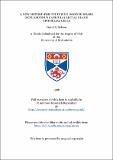Files in this item
A new method for culturing dogfish shark (Scyliorhinus canicula) rectal gland epithelial cells
Item metadata
| dc.contributor.advisor | Hazon, N. (Neil) | |
| dc.contributor.advisor | Cramb, Gordon | |
| dc.contributor.author | Nelson, David S. | |
| dc.coverage.spatial | 189 p. | en_US |
| dc.date.accessioned | 2018-07-05T16:27:05Z | |
| dc.date.available | 2018-07-05T16:27:05Z | |
| dc.date.issued | 1996 | |
| dc.identifier.uri | https://hdl.handle.net/10023/15019 | |
| dc.description.abstract | 1. Dogfish, Scyliorhinus canicula, rectal gland epithelial cells were successfully cultured using two different techniques: 1) a perfusion based technique and 2) a modified Valentich's technique (Valentich, 1991). 2. Growth stages of cultures were monitored, showing attachment of tubules at approximately two days with a complete monolayer formed between seven and ten days. Cultures were able to be maintained for up to twenty days. Photos were taken illustrating epithelial cell migration and cell viability. 3. Administration of Ca+2 and Mg+2 free Ringer + 2 mM ethylenediamine tetra-acetic acid (EDTA) + 1% trypsin successfully reduced cultures growing in 96-well plates to single cells after a time course of 20 min to allow for accurate cell counts of approximately 22,000 cells per well. 4. 10-6 M shark C-type natriuretic peptide (sCNP) induced stimulation of cGMP in cultured rectal gland epithelial cells over a time course of 240 sec with maximal stimulation occurring at 180 sec. Limited experiments with scyliorhinin II and rectin showed little effects in stimulating cGMP. | en_US |
| dc.language.iso | en | en_US |
| dc.publisher | University of St Andrews | |
| dc.subject.lcc | QL638.95S84N4 | en |
| dc.subject.lcsh | Scyliorhinidae | en |
| dc.title | A new method for culturing dogfish shark (Scyliorhinus canicula) rectal gland epithelial cells | en_US |
| dc.type | Thesis | en_US |
| dc.type.qualificationlevel | Doctoral | en_US |
| dc.type.qualificationname | PhD Doctor of Philosophy | en_US |
| dc.publisher.institution | The University of St Andrews | en_US |
This item appears in the following Collection(s)
Items in the St Andrews Research Repository are protected by copyright, with all rights reserved, unless otherwise indicated.

